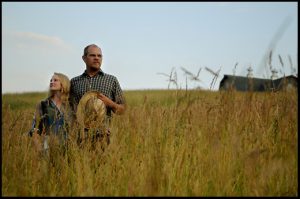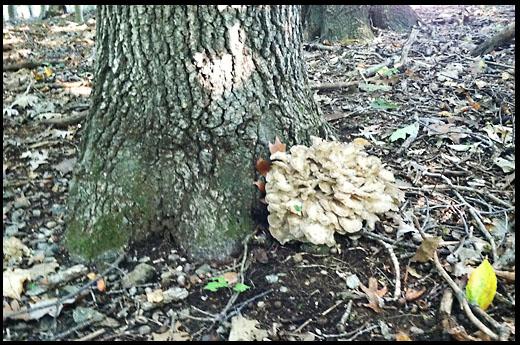by guest blogger Tim Mountz of Happy Cat Farm
Webster’s Dictionary says that foraging is the act of wandering in search of food. That definition makes me laugh, since I feel like I am always wandering somewhere in search of food. My parents and grandparents were all foragers, and I have been doing it for longer then I can remember. I’m not an expert, by far, but I know enough about wild mushrooms to encourage you to give foraging a try.
Here in Southern Pennsylvania, I eat four wild mushrooms and I know them very well: I hunt for morels in the spring, puffballs in late summer, chanterelles in late, late summer, and my favorite, hen-of-the-woods (Grifola frondosa), also known to many people as maitake, which is Japanese for “dancing mushroom,” in the fall.
This year, the brilliant heat of midsummer was cooled by almost a month of rain from mid-August through September. All that water put a quick end to an amazing tomato season, but it created the perfect storm for mushroom growth. And wow, is this a big year for hens! They are everywhere. I forage for four restaurants, and I literally collected a truckload of them one sunny morning. Most of the mushrooms are between two and six pounds, but the biggest one I found was 36 pounds. A friend of mine found one that was well over 63 pounds. Sixty-three pounds!
Here’s how to find hen-of-the-woods mushrooms:
Since hens do not grow on every tree, you’ll have to wander around a bit. For me, it’s a great reason to explore the shady, dappled woodlands that line the rolling fields of Pennsylvania’s Brandywine Valley. And, really, you’ll be hunting tree species, white and red oaks to be precise, for this is where the hens love to roost. Hens are terrestrial mushrooms, not arboreal, meaning they grow in the soil not on a tree. But they grow right at the base of the tree, where the roots meet the soil.
When I enter a stand of oaks I scan the base of the trees looking for the telltale clusters of whitish brown layers. Once you find your first one, you’ll see why they are called hen of the woods—they grow in feathered layers all attached at the base to the stem and they kind of look like hens sitting on a nest. When I come across the mushrooms, I like to stop and look around: I look at the type of oak tree, its age, what other trees are growing around it. I tend to find hens on older trees, those at least 70 years old. I’ve even seen them growing on standing dead oaks. The hens are actually a parasite and will eventually kill a tree; good thing for the oaks that these mushrooms are sought out by basket-carrying foragers.
The mushrooms should smell fresh and earthy and be free of insects. They should be firm and rubbery, not slimy. Healthy hens can be pure white to almost dark brown and a mix of both, but not orange. The broken flesh should be white or creamy. Keep in mind that I’m giving you a guide only. If you’re not confident that what you’ve found is edible, don’t eat it. Pick the wrong mushroom, and you can get very sick—or worse.
When you’re ready to harvest, just lift up one side of the mushroom, cut the stem as if you where cutting free a head of cauliflower, and put it in your basket. I harvest them using a Japanese soil knife called a hori-hori, which translates to “diggy-diggy” in Japanese. The hori-hori is a long-bladed tool with one serrated side.
Once I return from the woods, I give the mushrooms a quick dip in cold water for a minute or two, moving them around to get rid of any leaves, soil, or insects. Then I cut the stem off of the mushroom and cut up the smaller parts.
Maitake will keep for weeks in the crisper drawer of your fridge, but I like to eat them as soon as I can. As Euell Gibbons would say, “Wild things should be eaten in the wind.” I build a small fire, heat up a skillet, brown some butter, and toss in the mushrooms, about a quarter pound per person. I sauté them until they are golden brown and soft. Right before the mushrooms come out of the pan I grind fresh thyme over them, serve, and eat them in the wind.
 Tim and his wife Amy own Happy Cat Farm, an organic farm and lifestyle brand located just outside of Kennett Square, PA [www.happycatorganics.com].
Tim and his wife Amy own Happy Cat Farm, an organic farm and lifestyle brand located just outside of Kennett Square, PA [www.happycatorganics.com].






which part of the country are you as to gathering those gigantic mushrooms?
We live and forage in Southeastern PA and Northern Delaware.
My sister lives in the off-skirt of Redding, PA. Can you mail me some of your forage? I will pay freight! Smile.
I love my mushrooms with my Salisbury steak and chowders!
with garlic and shallots shaggy mane & parasols
Just as a note fyi, mushrooms that feed on living trees are pathogens (not parasites), and mushrooms that feed on dead trees are saprobes. Just thought you would like to know 🙂
I live north of you in Easton, and was wondering if you ever take out groups to learn how and where to look for Morels ? I have been out over a doz. times looking and found none.. Last fall I found over 70 lbs of hens in the poconos.. but morels are my next goal … I would travel to learn.. I can’t do great walking since I am a disabled vet… But wi;; give it a shot ..please !!!
Hi! I was wondering if the idea of taking two novice foragers out to explore would be of interest to you. Well be in the area at the end of November and were hoping to start our foraging education. If you are not – do you have any friends that teach some sort of class like this while out exploring the practical application of the lessons?
Rev. Tom – I also live in Easton! I’m just starting to read about mycology and foraging. Let me know if you want to get in touch.